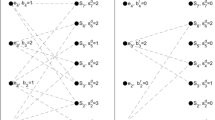Abstract
The set covering problem has many diverse applications to problems arising in crew scheduling, facility location and other business areas. Since the problem is known to be hard to solve optimally, a number of approximate (heuristic) approaches have been designed for it. These approaches (with one exception) divide into two main groups, greedy heuristics and dual saturation heuristics. We use the concept of a Pareto optimal dual solution to show that an arbitrary dual saturation heuristic has the same worst-case performance guarantee as the two best known heuristics of that type. Moreover, this poor performance level is always attainable by those two heuristics.
Similar content being viewed by others
References
E. Balas, A class of location, distribution and scheduling problems: modeling and solution methods, paper presented at theChinese-American Symp. on Systems Analysis and Engineering, Xian (1981).
E. Balas, A sharp bound on the ratio between optimal integer and fractional covers, Math. Oper. Res. 9(1984)1.
E. Balas and A. Ho, Set covering algorithms using cutting planes, heuristics and subgradient optimization: a computational study, Math. Progr. Study 12(1980)37.
R. Bar Yehuda and S. Even, A linear time approximation algorithm for the weighted vertex cover problem, J. Algor. 2(1981)198.
J.W.S. Cassels,Economics for Mathematicians (Cambridge University Press, 1982).
V. Chvátal, A greedy heuristic for the set-covering problem, Math. Oper. Res. 4(1979)233.
M.R. Garey and D.S. Johnson,Computers and Intractability: a Guide to the Theory of NP-Completeness (Freeman, San Francisco, 1979).
N.G. Hall and D.S. Hochbaum, The multicovering problem: the use of heuristics, cutting planes, and subgradient optimization for a class of integer programs, manuscript, University of California, Berkeley (1983).
N.G. Hall and D.S. Hochbaum, A fast approximation algorithm for the multicovering problem, Discr. Appl. Math. 15(1986)35.
A.C. Ho, Worst case analysis of a class of set covering heuristics, Math. Progr. 23(1982)170.
D.S. Hochbaum, Approximation algorithms for the set covering and vertex cover problems, SIAM J. Comput. 11(1982)555.
D.S. Johnson, Approximation algorithms for combinatorial problems, J. Comp. Syst. Sci. 9(1974)256.
Author information
Authors and Affiliations
About this article
Cite this article
Hall, N.G., Vohra, R.V. Pareto optimality and a class of set covering heuristics. Ann Oper Res 43, 279–284 (1993). https://doi.org/10.1007/BF02025298
Issue Date:
DOI: https://doi.org/10.1007/BF02025298




